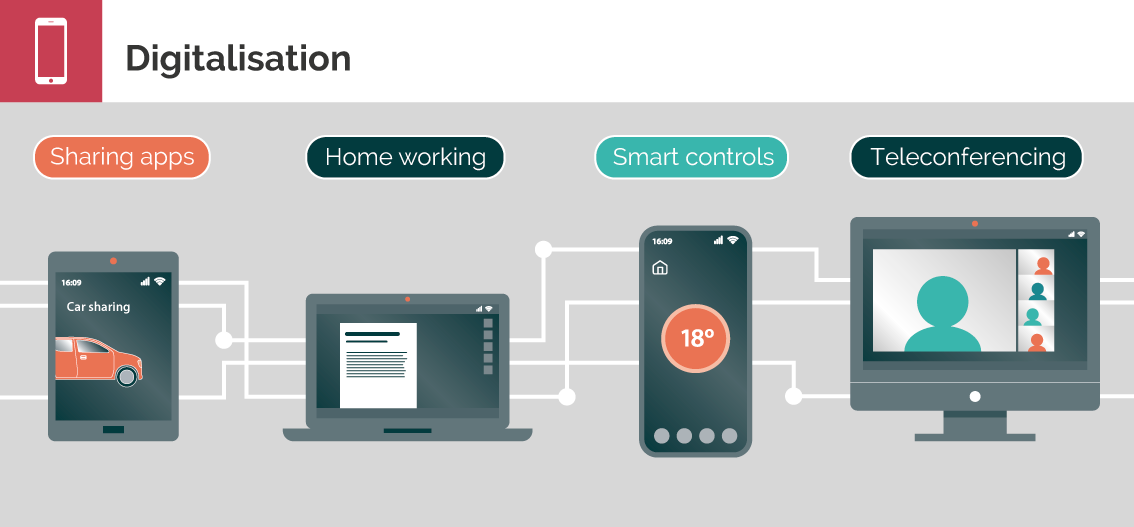
Digitalisation is a global mega-trend with profound implications for society and therefore energy use. Digital technologies have the potential to enable large energy savings in three ways: first by using digitalisation to optimise energy control, secondly by substituting information for material goods and services, and thirdly by enabling sharing of material goods.
Although there is limited evidence for the achievement of energy savings in the past, digital technologies could lead to significant reductions in energy use. However, this is dependent on future energy saving benefits exceeding growth in demand due to information processing and communications, which is uncertain [1]. In any event, policy intervention is needed to capture these benefits.
Control systems have always been a contributor to energy saving, but the growth of digital technologies and services provides new, lower cost solutions in all sectors. Digitalisation is implicit in many of the solutions discussed in other sections. The future speed and long-term extent of digitalisation is still a matter of debate in many applications, notably autonomous vehicles [2].
The use of digital technologies and services to substitute for material goods and services is now widespread, for example e-healthcare, e-music, e-books, teleworking and video-conferencing. The main energy saving benefits are from the potential for reduced energy use in manufacturing and travel. In practice, the extent to which these are realised is complex and depends on how the new services are used and how they affect other activities [3].
Smart home technologies involve a diversity of technologies, business models and services. In principle, they offer opportunities for increasing user control, thereby facilitating energy saving and demand-side response. However, strong policy steers will be required to capture these benefits [4]. New digital platforms can facilitate the sharing of material goods, for example by car sharing, ride-sharing, bike-sharing, peer-to-peer exchange of goods and food-pairing apps. In many cases, sharing business models are community-based and depend on the desire of users to contribute to the development of their local community. They offer opportunities to reduce energy use, although the potential for doing this is usually a secondary concern and largely invisible for most users [5].
All these technologies have rebounds, as efficiency improvements can encourage greater consumption of goods and services [6]. Digital technologies can induce demand for entirely new goods and services. Evidence from some applications, for example autonomous vehicles, suggests that these can lead to a net increase in energy consumption. Claims that energy savings facilitated by digital technologies exceed their direct energy use often lack a firm empirical foundation. However, with the right policy and market mechanisms in place, digital solutions can deliver significant energy savings.
Estimates of the future impacts of digitalization vary widely and include a complex mix of direct and indirect effects in home energy use, transport and other sectors. Some possible trends (e.g. growth in privately-owned autonomous vehicles) could encourage increased energy consumption, but many of the scenarios project a net reduction in energy demand [7].
Evidence
- Koomey’s law forevermore? A document analysis of the production and circulation of the promise of ‘green 5G’ | Research paper, 2023
- The expected speed and impacts of vehicle automation in passenger and freight transport: A Dissensus Delphi study among UK professionals | Research paper, 2023
- Digitalisation of goods: a systematic review of the determinants and magnitude of the impacts on energy consumption | Research paper, 2020
- Policy mixes for more sustainable smart home technologies | Research paper, 2021
- Borrowing, energy demand and Covid: a model for disruption | Research paper, 2021
- Energy efficiency and economy-wide rebound effects: a review of the evidence and its implications | Research paper, 2021
- Drivers and effects of digitalization on energy demand in low carbon scenarios | Research paper, 2021
Banner photo credit: Pat Whelen on Unsplash
